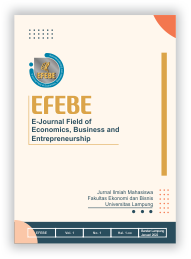ANALISIS SEKTOR EKONOMI UNGGULAN TERHADAP PEMBANGUNAN WILAYAH DI KABUPATEN PESISIR BARAT
DOI:
https://doi.org/10.23960/efebe.v3i3.291Keywords:
Leading sector, Location Quotient, Regional DevelopmentAbstract
This study seeks to determine the primary economic sectors and assess their impact on regional development in Pesisir Barat Regency. Achieving sustainable regional growth necessitates the identification of strategic sectors capable of driving economic progress and enhancing the well-being of local communities. A descriptive quantitative method is employed in this research, utilizing the Location Quotient (LQ) technique to pinpoint basic sectors. Additionally, a sectoral typology analysis is conducted by examining the average LQ alongside the analysis focuses on the average contribution to the Gross Regional Domestic Product (GRDP), using GRDP data at constant 2010 prices for the period 2018 to 2022, obtained from the Central Bureau of Statistics (BPS). The results reveal that the Agriculture, Forestry, and Fisheries sector, along with the Wholesale and Retail Trade; Repair of Motor Vehicles and Motorcycles sector, are classified as basic sectors and are situated in Quadrant I. As such, implementing targeted and sustainable development strategies is essential. These may include boosting investment, upgrading infrastructure, supporting local entrepreneurs, and improving human capital. The insights and recommendations from this research are intended to guide regional policymakers in crafting effective development strategies that leverage the region’s economic strengths.
Downloads
Published
How to Cite
Issue
Section
License
Copyright (c) 2025 Fuad Azka, Zulfa Emalia, Resha Moniyana

This work is licensed under a Creative Commons Attribution-ShareAlike 4.0 International License.
E-journal Field of Economics, Business and Entrepreneurship is licensed under a Creative Commons Attribution-ShareAlike 4.0 International License Copyright Notice.









